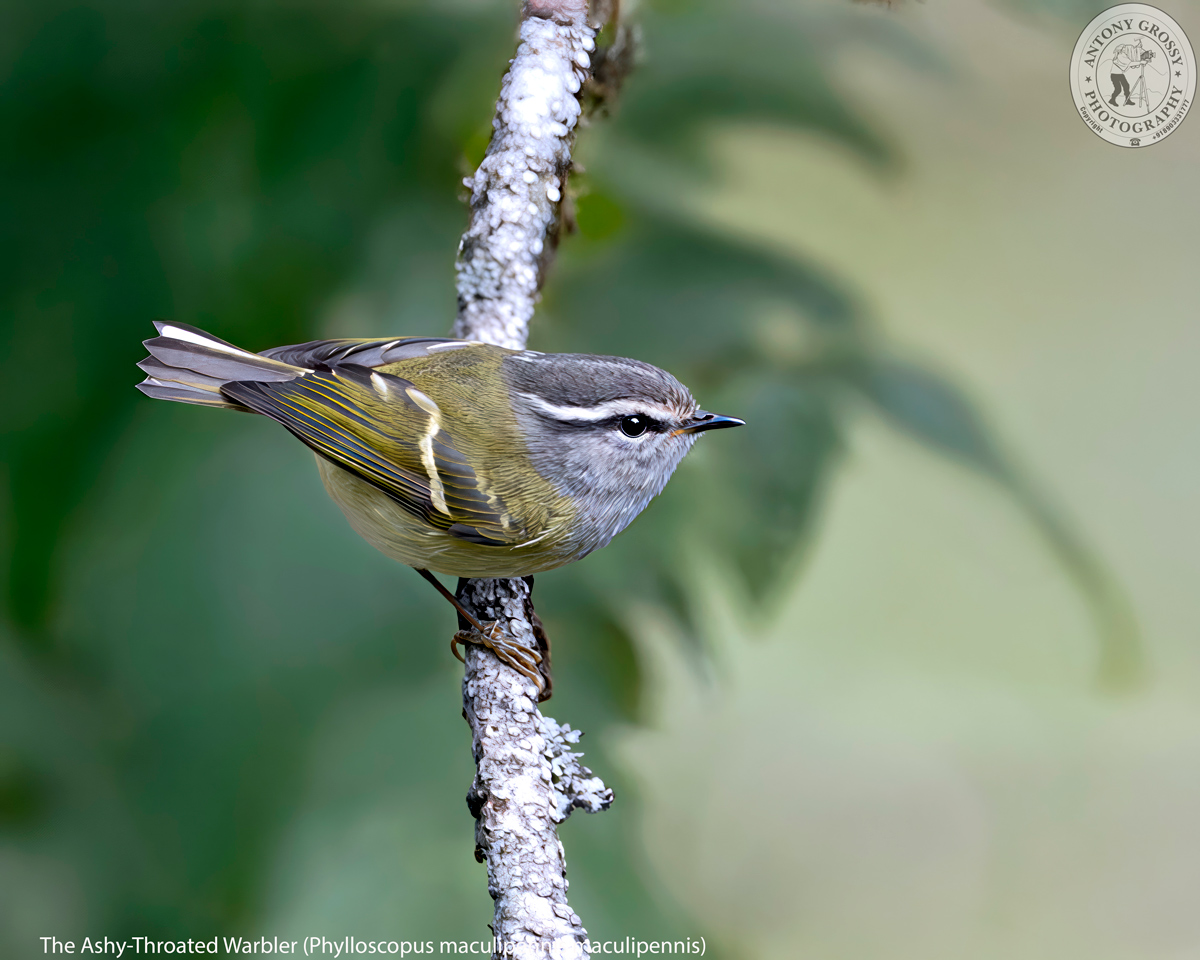

|
 |
| The Canopy Dwelling Warbler of Hill Forests – The Ashy-Throated Warbler |
| The Ashy-Throated Warbler is fairly distinctive
for a leaf Warbler with its grey head and snow-white brow stripe. Active and agile inhabitant of foothill to montane forests, where it often joins mixed-species flocks. Ashen-grey head distinguishes it from most other leaf warblers; Buff-barred Warbler occasionally has a greyish head but has a yellowish brow stripe instead of a white one. Frequently hovers, during which bright white tail edges are often visible. A canopy dweller and feeder, hence difficult to get eye level photographs. . . . . . . . .. .. …. ……. . .. … …… ………………………. ………….. ……………….. .. …. …. ……….. … …. ……….. … …. ………… ………….. ………… ………… ….. ………. …………. …….. ……………. …… …. …. ……….. … …. ……….. .. ………… ….. ………. …………. …….. …………. The Ashy-Throated Warbler is a small and extremely active leaf-warbler with small and delicate-looking bill, with pronounced head stripes, wingbars and pale rump. It measures about 10 cms in length and weighs about 6 gms. The Nominate race has crown and nape side dark grey-green, with whitish or greyish-white crownstripe to centre of nape; long white supercilium, equally long dark brown eyestripe; mantle, back, scapulars and upperwing-coverts bright green, median coverts narrowly tipped yellowish-white, greater coverts more broadly tipped the same, rump pale yellow; flight-feathers and tail feathers dark brown, inner webs of outer three tail feathers white (frequently seen when tail flicked); chin to cheek and upper breast pale grey, rest of underparts bright yellow; iris dark brown; bill black, base of lower mandible yellowish or dull pinkish; legs yellowish to pinkish-brown. The Sexes are alike. Juvenile has upperparts browner, with buffish tinge in wingbars, and paler throat and breast than adult. Two subspecies are recognized both having slightly different colourations and plumage. . . . . . . . .. .. …. ……. . .. … …… ………………………. ………….. ……………….. .. …. …. ……….. … …. ……….. … …. ………… ………….. ………… ………… ….. ………. …………. …….. ……………. …… …. …. ……….. … …. ……….. .. ………… ….. ………. …………. …….. …………. Distinguished from The Buff-Barred warbler mainly by slightly smaller size, darker crown, white supercilium, yellowish-white (not orange) wingbars, grey face, yellower underparts; from The Pallas’s Leaf Warbler by whiter supercilium, darker crown side, duller crownstripe, deeper yellowish wingbars, white in outer tail, grey face, yellowish underparts. . . . . . . . .. .. …. ……. . .. … …… ………………………. ………….. ……………….. .. …. …. ……….. … …. ……….. … …. ………… ………….. ………… ………… ….. ………. …………. …….. ……………. …… …. …. ……….. … …. ……….. .. ………… ….. ………. …………. …….. …………. The Ashy-Throated Warbler is found in the Himalayas, Yunnan, North- East India and Northern Indochina. Its natural habitats are temperate forests and subtropical or tropical moist lowland forests. It is found during breeding season in mixed oak and conifer forests with thick undergrowth, particularly rhododendrons and bushes, between 1800 to 3500 mtrs. They can also be found in open forests with ample undergrowth where they generally prefer foraging close to the ground; in non-breeding season found in broadleaf forest and secondary forest in foothills and lowlands, between 600 to 2100 mtrs. Altitudinal migrant, making post-breeding descent from high levels to lowlands and foothills. . . . . . . . .. .. …. ……. . .. … …… ………………………. ………….. ……………….. .. …. …. ……….. … …. ……….. … …. ………… ………….. ………… ………… ….. ………. …………. …….. ……………. …… …. …. ……….. … …. ……….. .. ………… ….. ………. …………. …….. …………. These birds are quite agile and active, often seen flicking their wings while hopping between branches or hovering around to catch insects. Their flight is undulating, characterized by rapid wingbeats interspersed with brief gliding. As an insectivore, The Ashy-Throated Warbler feeds on a diet primarily made up of insects and their larvae. Forages singly or, in non-breeding season, in mixed-species flocks. Keeps high in trees, and forages mostly in canopy. Restless and extremely active; flicks wings and tail (showing white outer edges) while foraging. . . . . . . . .. .. …. ……. . .. … …… ………………………. ………….. ……………….. .. …. …. ……….. … …. ……….. … …. ………… ………….. ………… ………… ….. ………. …………. …….. ……………. …… …. …. ……….. … …. ……….. .. ………… ….. ………. …………. …….. …………. Its Song is a whistled series of sweet phrases all of same tone, ti-wee-ty wee-ty wee-ty, similar to song of The Davison’s Leaf Warbler; also a slower whee-teew whee-teew. Call a sharp and high-pitched tit, zip, swit or zit, often repeated frequently, and similar to that given by The Pallas’s Leaf Warbler. . . ……… … …. ………… ………….. ………… ………… ….. ………. …… ………….. ………… ………… ….. ………………….. … ………… ….. ………. …… ………….. ………… ………… ….. …… ………….. …………. …. …. … ……………. ………… ….. ……………………………. …. …. … .. …………………. …. …………………….. ….. …………….. .. Description Credit Birds of the World (The Cornell Lab), Oiseaux, Animalia, Ogaclicks, Birds of India | Bird World, Bird Count India & Wiki. |
  |
|
|






































































































































































































































































































































































































































































































































































































































































